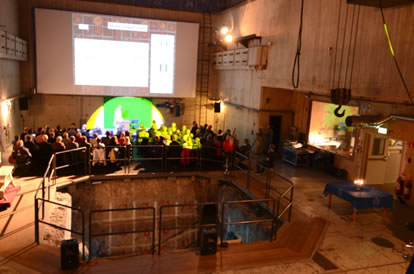
Swedish Nuclear Energy celebrated 60 years
On 22 September 2014, 100 Swedish nuclear representatives, primarily from industry and academia, gathered in the reactor hall of the first Swedish nuclear reactor, “R1”, 25 m underground in the central part of Stockholm, to celebrate the first ever criticality, which occurred on July 13 1954. The celebration also brought together nuclear pioneers from the time when the now decommissioned heavy-water reactor was in operation. Professor Emeritus Karl-Erik Larsson, 91, gave a much-appreciated talk on the groundbreaking research that he supervised at R1 in the late 50s. R1 was not only the first reactor to be developed by Sweden’s nuclear energy programme, but was also an important tool for neutron physics research as a whole. The experiments carried out at R1 attracted great interest on an international level and at least three Nobel Prize laureates were involved in research closely associated with it.
‘R1 proved to be a successful enterprise that paved the way for the development of the Swedish nuclear energy programme, a programme that had broad competence within the diverse knowledge field of nuclear energy,’ said Prof. Larsson.
Dr Maja Fjaestad, from the KTH Royal Institute of Technology, gave a talk on the connection between the R1 reactor and the nuclear power reactors currently in operation in Sweden today. During the decades after the Second World War, a new wave of optimism swept society, and the development of nuclear technology in the service of humankind was an obvious component of that bright emrging future. R1 was the first step along the so-called Swedish Line, according to which Sweden was supposed to be self-sufficient for nuclear energy thanks to the use of natural uranium and heavy-water reactors. However, global politics and technological development decided otherwise, and an industrial light-water reactor fleet was developed in Sweden during the 70s and 80s.
The celebratory events in the R1 reactor hall were followed by a dinner during which relatives of the early decision-makers involved in the development of R1, such as Harry Brynielsson and the former IAEA Director Sigvard Eklund, gave memorable speeches.
The event was organised by the Swedish Nuclear Society (SKS) and the KTH, with support from the Swedish Centre for Nuclear Technology (SKC).

The Swedish Nuclear Society (SKS). |

